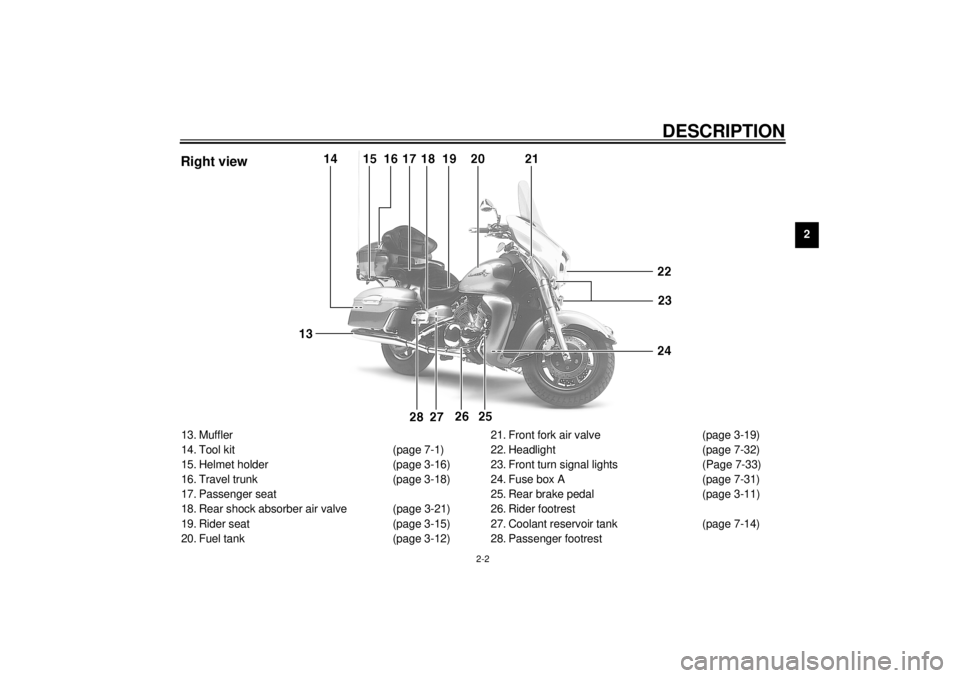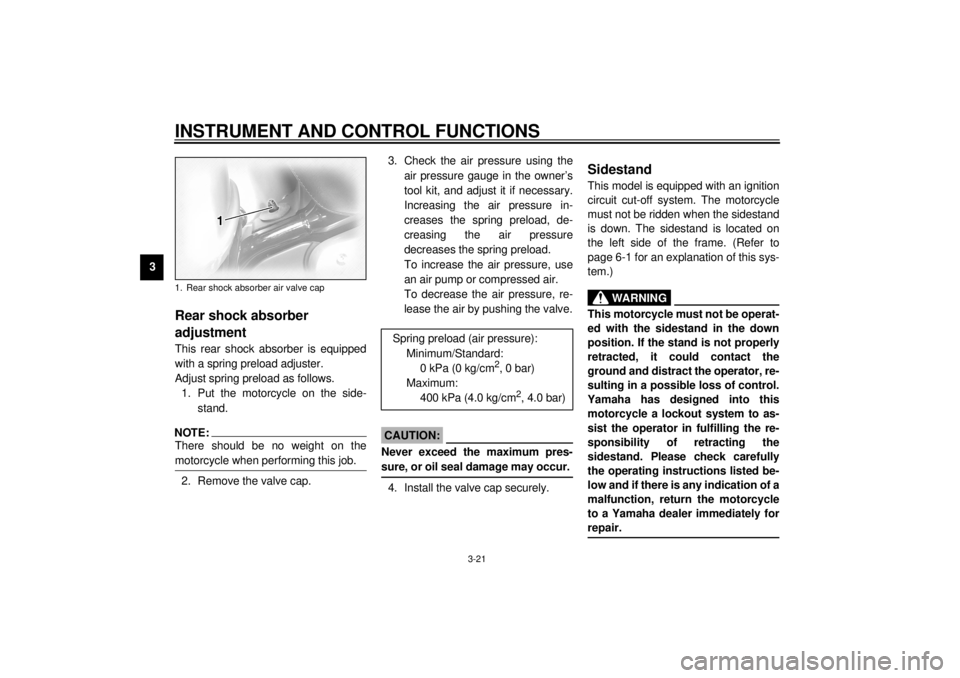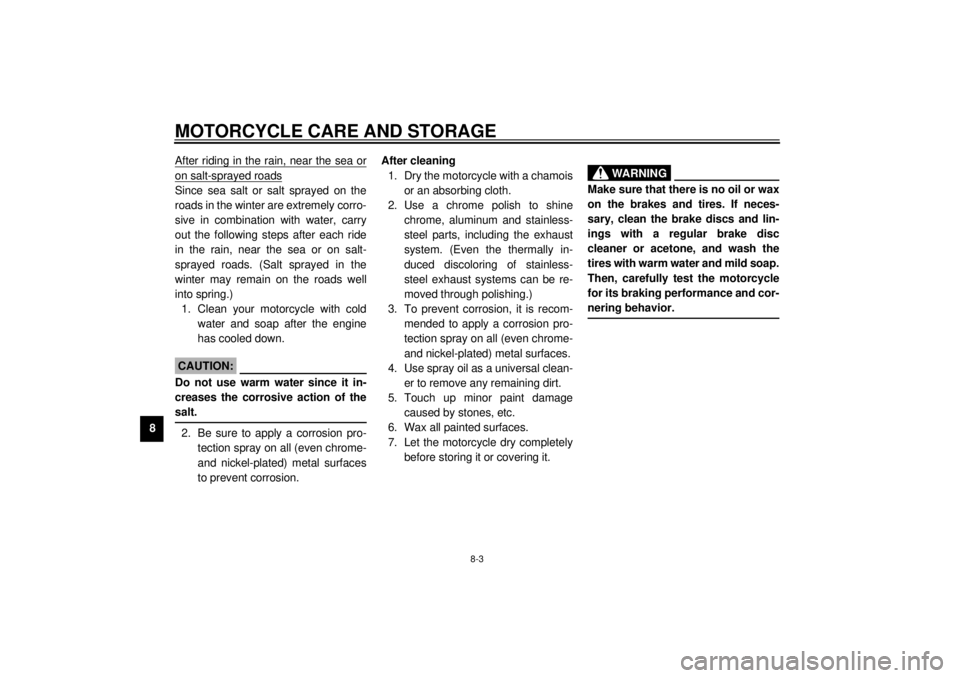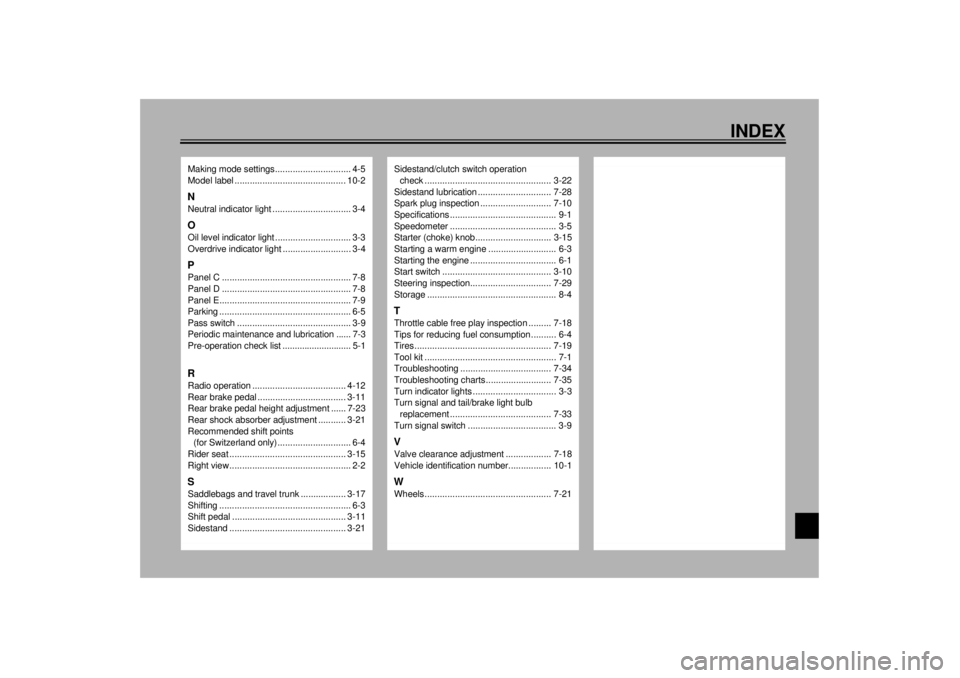2000 YAMAHA XVZ1300TF ABS
[x] Cancel search: ABSPage 12 of 121

DESCRIPTION
2-2
2
13. Muffler
14. Tool kit (page 7-1)
15. Helmet holder (page 3-16)
16. Travel trunk (page 3-18)
17. Passenger seat
18. Rear shock absorber air valve (page 3-21)
19. Rider seat (page 3-15)
20. Fuel tank (page 3-12)21. Front fork air valve (page 3-19)
22. Headlight (page 7-32)
23. Front turn signal lights (Page 7-33)
24. Fuse box A (page 7-31)
25. Rear brake pedal (page 3-11)
26. Rider footrest
27. Coolant reservoir tank (page 7-14)
28. Passenger footrestRight view
E_5jc_Description.fm Page 2 Saturday, October 16, 1999 1:07 PM
Page 14 of 121

3
INSTRUMENT AND CONTROL FUNCTIONS
Main switch/steering lock ...................................... 3-1
Indicator lights ...................................................... 3-3
Speedometer ........................................................ 3-5
Cruise control system ........................................... 3-7
Antitheft alarm (optional) ...................................... 3-8
Fuel gauge ............................................................ 3-9
Handlebar switches .............................................. 3-9
Clutch lever ......................................................... 3-10
Shift pedal ........................................................... 3-11
Front brake lever ................................................. 3-11
Rear brake pedal ................................................ 3-11
Fuel tank cap ...................................................... 3-12Fuel .................................................................... 3-13
Fuel tank breather hose ..................................... 3-13
Fuel cock ............................................................ 3-14
Starter (choke) knob .......................................... 3-15
Rider seat........................................................... 3-15
Helmet holders ................................................... 3-16
Saddlebags and travel trunk .............................. 3-17
Front fork adjustment ......................................... 3-19
Rear shock absorber adjustment ....................... 3-21
Sidestand ........................................................... 3-21
Sidestand/clutch switch operation check............ 3-22
Auxiliary DC jack and terminal ........................... 3-23
E_5jc_FunctionsTOC.fm Page 1 Saturday, October 16, 1999 1:07 PM
Page 35 of 121

INSTRUMENT AND CONTROL FUNCTIONS
3-21
3
EAU01879*
Rear shock absorber
adjustmentThis rear shock absorber is equipped
with a spring preload adjuster.
Adjust spring preload as follows.
1. Put the motorcycle on the side-
stand.NOTE:@ There should be no weight on the
motorcycle when performing this job. @2. Remove the valve cap.3. Check the air pressure using the
air pressure gauge in the owner’s
tool kit, and adjust it if necessary.
Increasing the air pressure in-
creases the spring preload, de-
creasing the air pressure
decreases the spring preload.
To increase the air pressure, use
an air pump or compressed air.
To decrease the air pressure, re-
lease the air by pushing the valve.
EC000012
CAUTION:@ Never exceed the maximum pres-
sure, or oil seal damage may occur. @4. Install the valve cap securely.
EAU00330
SidestandThis model is equipped with an ignition
circuit cut-off system. The motorcycle
must not be ridden when the sidestand
is down. The sidestand is located on
the left side of the frame. (Refer to
page 6-1 for an explanation of this sys-
tem.)
EW000044
WARNING
@ This motorcycle must not be operat-
ed with the sidestand in the down
position. If the stand is not properly
retracted, it could contact the
ground and distract the operator, re-
sulting in a possible loss of control.
Yamaha has designed into this
motorcycle a lockout system to as-
sist the operator in fulfilling the re-
sponsibility of retracting the
sidestand. Please check carefully
the operating instructions listed be-
low and if there is any indication of a
malfunction, return the motorcycle
to a Yamaha dealer immediately for
repair. @
1. Rear shock absorber air valve cap
Spring preload (air pressure):
Minimum/Standard:
0 kPa (0 kg/cm
2, 0 bar)
Maximum:
400 kPa (4.0 kg/cm
2, 4.0 bar)
E_5jc_Functions.fm Page 21 Saturday, October 16, 1999 1:08 PM
Page 70 of 121

PERIODIC MAINTENANCE AND MINOR REPAIR
7-4
7
11
*Wheel bearings• Check bearing for looseness or damage.
• Replace if necessary. ÖÖ
12*Swingarm• Check swingarm pivoting point for play.
• Correct if necessary.
• Lubricate with molybdenum disulfide grease every 24,000 km or
24 months (whichever comes first).ÖÖ
13*Steering bearings• Check bearing play and steering for roughness.
• Correct accordingly.
• Lubricate with lithium soap base grease every 24,000 km
or 24 months (whichever comes first).ÖÖ
14*Chassis fasteners• Make sure that all nuts, bolts and screws are properly tightened.
• Tighten if necessary.ÖÖ
15 Sidestand• Check operation.
• Lubricate and repair if necessary.ÖÖ
16*Sidestand switch• Check operation.
• Replace if necessary.ÖÖÖ
17*Front fork• Check operation and for oil leakage.
• Correct accordingly.ÖÖ
18*Rear shock absorber
assembly• Check operation and shock absorber for oil leakage.
• Replace shock absorber assembly if necessary. ÖÖ
19*Rear suspension relay
arm and connecting arm
pivoting points• Check operation.
• Lubricate with molybdenum disulfide grease every 24,000 km or
24 months (whichever comes first).ÖÖ
20*Carburetors• Check engine idling speed, synchronization and starter operation.
• Adjust if necessary.ÖÖÖ
21 Engine oil• Check oil level and vehicle for oil leakage.
• Correct if necessary.
• Change. (Warm engine before draining.)ÖÖÖ
22 Engine oil filter cartridge• Replace.ÖÖ NO. ITEM CHECKS AND MAINTENANCE JOBSINITIAL
(1,000 km)EVERY
6,000 km
or
6 months
(whichever
comes first)12,000 km
or
12 months
(whichever
comes first)
E_5jc_Periodic.fm Page 4 Saturday, October 16, 1999 1:10 PM
Page 107 of 121

MOTORCYCLE CARE AND STORAGE
8-3
8After riding in the rain, near the sea or
on salt-sprayed roadsSince sea salt or salt sprayed on the
roads in the winter are extremely corro-
sive in combination with water, carry
out the following steps after each ride
in the rain, near the sea or on salt-
sprayed roads. (Salt sprayed in the
winter may remain on the roads well
into spring.)
1. Clean your motorcycle with cold
water and soap after the engine
has cooled down.
ECA00012
CAUTION:@ Do not use warm water since it in-
creases the corrosive action of the
salt. @2. Be sure to apply a corrosion pro-
tection spray on all (even chrome-
and nickel-plated) metal surfaces
to prevent corrosion.After cleaning
1. Dry the motorcycle with a chamois
or an absorbing cloth.
2. Use a chrome polish to shine
chrome, aluminum and stainless-
steel parts, including the exhaust
system. (Even the thermally in-
duced discoloring of stainless-
steel exhaust systems can be re-
moved through polishing.)
3. To prevent corrosion, it is recom-
mended to apply a corrosion pro-
tection spray on all (even chrome-
and nickel-plated) metal surfaces.
4. Use spray oil as a universal clean-
er to remove any remaining dirt.
5. Touch up minor paint damage
caused by stones, etc.
6. Wax all painted surfaces.
7. Let the motorcycle dry completely
before storing it or covering it.
EWA00001
WARNING
@ Make sure that there is no oil or wax
on the brakes and tires. If neces-
sary, clean the brake discs and lin-
ings with a regular brake disc
cleaner or acetone, and wash the
tires with warm water and mild soap.
Then, carefully test the motorcycle
for its braking performance and cor-
nering behavior. @
E_5jc_Cleaning.fm Page 3 Saturday, October 16, 1999 1:12 PM
Page 113 of 121

SPECIFICATIONS
9-3
9
Maximum load* 190 kg
Air pressure (cold tire)
Up to 90 kg load*
Front 250 kPa (2.50 kg/cm
2, 2.50 bar)
Rear 250 kPa (2.50 kg/cm2, 2.50 bar)
90 kg load ~ maximum
load*
Front 250 kPa (2.50 kg/cm2, 2.50 bar)
Rear 280 kPa (2.80 kg/cm2, 2.80 bar)
* Load is total weight of cargo, rider, passenger and accessories.
Wheels
Front
Ty p e C a s t
Size 16 ´ MT 3.50
Rear
Ty p e C a s t
Size 15M/C ´ MT 4.00
Brakes
Front
Type Dual disc brake
Operation Right hand operation
Fluid DOT 4Rear
Type Single disc brake
Operation Right foot operation
Fluid DOT 4
Suspension
Fr o n t
Ty p e Te l e s c o p i c f o r k
Rear
Type Swingarm (link suspension)
Shock absorber
Front Coil-air spring/oil damper
Rear Coil-air spring/oil damper
Wheel travel
Front 140 mm
Rear 105 mm
Electrical
Ignition system T.C.I. (digital)
Charging system
Type A.C. magneto
Standard output 14 V, 29 A @ 5,000 r/min
Battery
Type YTX20L-BS
Voltage, capacity 12 V, 18 AH
E_5jc_Spec.fm Page 3 Saturday, October 16, 1999 1:12 PM
Page 120 of 121

INDEX
Making mode settings.............................. 4-5
Model label ............................................ 10-2NNeutral indicator light ............................... 3-4OOil level indicator light .............................. 3-3
Overdrive indicator light ........................... 3-4PPanel C ................................................... 7-8
Panel D ................................................... 7-8
Panel E.................................................... 7-9
Parking .................................................... 6-5
Pass switch ............................................. 3-9
Periodic maintenance and lubrication ...... 7-3
Pre-operation check list ............................ 5-1RRadio operation ..................................... 4-12
Rear brake pedal ................................... 3-11
Rear brake pedal height adjustment ...... 7-23
Rear shock absorber adjustment ........... 3-21
Recommended shift points
(for Switzerland only)............................. 6-4
Rider seat .............................................. 3-15
Right view................................................ 2-2SSaddlebags and travel trunk .................. 3-17
Shifting .................................................... 6-3
Shift pedal ............................................. 3-11
Sidestand .............................................. 3-21
Sidestand/clutch switch operation
check .................................................. 3-22
Sidestand lubrication ............................. 7-28
Spark plug inspection ............................ 7-10
Specifications .......................................... 9-1
Speedometer .......................................... 3-5
Starter (choke) knob.............................. 3-15
Starting a warm engine ........................... 6-3
Starting the engine .................................. 6-1
Start switch ........................................... 3-10
Steering inspection................................ 7-29
Storage ................................................... 8-4TThrottle cable free play inspection ......... 7-18
Tips for reducing fuel consumption .......... 6-4
Tires...................................................... 7-19
Tool kit .................................................... 7-1
Troubleshooting .................................... 7-34
Troubleshooting charts .......................... 7-35
Turn indicator lights ................................. 3-3
Turn signal and tail/brake light bulb
replacement ........................................ 7-33
Turn signal switch ................................... 3-9VValve clearance adjustment .................. 7-18
Vehicle identification number................. 10-1WWheels .................................................. 7-21
E_5jcIX.fm Page 2 Saturday, October 16, 1999 1:12 PM